Photo








Evolution of Chinese Clothing and Cheongsam
the refs: http://i6.photobucket.com/albums/y246/lilsuika/refs.jpg
Alt: Timeline as 1 cohesive file at http://lilsuika.deviantart.com/
Chinese clothing has approximately 5,000 years of history behind it, but regrettably I am only able to cover 2,500 years in this fashion timeline. I began with the Han dynasty as the term hanfu (meaning: dress of ethnic Chinese people) was coined in that period. Please bear in mind that this is only a generalized timeline of Chinese clothing primarily featuring aristocratic and upper-class ethnic Han Chinese women (the exceptions are Fig. 8 (dancer) and Fig. 11 (maid, due to the fact I couldn’t find many paintings in the Yuan period)).
My resources are mainly the books: 5,000 years of Chinese Costume, China Chic: East Meets West, Changing Clothes in China: Fashion, History, Nation, and Hong Kong Museum of History. 5,000 years of Chinese Costume is an invaluable resource in English (though sadly currently out of print), I would highly recommend this book if you can get your hands on it.
NOTES OF INTEREST:
Han Dynasty:
“In the Han Dynasty, as of old, the one-piece garment remained the formal dress for women. However, it was somewhat different from that of the Warring States Period, in that it had an increased number of curves in the front and broadened lower hems. Close-fitting at the waist, it was always tied with a silk girdle.” (5,000 years of Chinese Costume, pg. 32)
Wei and Jin dynasties:
“On the whole, the costumes of the Wei and Jin period still followed the patterns of Qin and Han.” (5,000 years of Chinese Costume, pg. 54)
“From the costumes worn by the benefactors in the Dunhuang murals and the costumes of the pottery figurines unearthed in Louyang, it can be seen that women’s costumes in the period of Wei and Jin were generally large and loose. The upper garment opened at the front and was tied at the waist. The sleeves were broad and fringed at the cuffs with decorative borders of a different colour. The skirt had spaced coloured stripes and was tied with a white silk band at the waist. There was also an apron between the upper garment and skirt for the purpose of fastening the waist. Apart from wearing a multi-coloured skirt, women also wore other kinds such as the crimson gauze-covered skirt, the red-blue striped gauze double skirt, and the barrel-shaped red gauze skirt. Many of these styles are mentioned in historical records.” (5,000 years of Chinese Costume, pg. 65)
Southern and Northern Dynasties:
“During the Wei, Jin and the Southern and Northern Dynasties, though men no longer wore the traditional one-piece garment, some women continued to do so. However, the style was quite different from that seen in the Han Dynasty. Typically the women’s dress was decorated with xian and shao. The latter refers to pieces of silk cloth sewn onto the lower hem of the dress, which were wide at the top and narrow at the bottom, so that triangles were formed overlapping each other. Xian refers to some relatively long ribbons which extended from the short-cut skirt. While the wearer was walking, these lengthy ribbons made the sharp corners n the lower hem wave like a flying swallow, hence the Chinese phrase ‘beautiful ribbons and flying swallowtail’.” (5,000 years of Chinese Costume, pg. 62)
“During the Southern and Northern Dynasties, costumes underwent further changes in style. The long flying ribbons were no longer seen and the swallowtailed corners became enlarged. As a result the flying ribbons and swallowtailed corners were combined into one.” (5,000 years of Chinese Costume, pg. 62)
Sui Dynasty:
“During the period of the Sui and early Tang, a short jacket with tight sleeves was worn in conjunction with a tight long skirt whose waist was fastened almost to the armpits with a silk ribbon. In the ensuing century, the style of this costume remained basically the same, except for some minor changes such as letting out the jacket and/or its sleeves.” (5,000 years of Chinese Costume, pg. 88)
Tang Dynasty:
“The Tang Dynasty was the most prosperous period in China’s feudal society. Changan (now Xian, Shananxi Province), the capital, was the political, economic and cultural centre of the nation. […] Residents in Changan included people of such nationalities as Huihe (Uygur,) Tubo (Tibetan), and Nanzhao (Yi), and even Japanese, Xinluo (Korean), Persian and Arabian. Meanwhile, people frequently travelled to and fro between countries like Vietnam, India and the East Roman Empire and Changan, thus spreading Chinese culture to other parts of the world.” (5,000 years of Chinese Costume, pg. 76)
“…all the national minorities and foreign envoys who thronged the streets of Changan also contributed something of their own culture to the Tang. Consequently, paintings, carvings, music and dances of the Tang absorbed something of foreign skills and styles. The Tang government adopted the policy of taking in every exotic form whether or hats or clothing, so that Tang costumes became increasingly picturesque and beautiful.” (5,000 years of Chinese Costume, pg. 88)
“Women of the Tang Dynasty paid particular attention to facial appearance, and the application of powder or even rouge was common practice. Some women’s foreheads were painted dark yellow and the dai (a kind of dark blue pigment) was used to paint their eyebrows into different shapes that were called dai mei (painted eyebrows) in general.” (5,000 years of Chinese Costume, pg. 89)
“In the years of Tianbao during Emperor Xuanzong’s reign, women used to wear men’s costumes. This was not only a fashion among commoners, but also for a time it spread to the imperial court and became customary for women of high birth.” (5,000 years of Chinese Costume, pg. 89)
Song Dynasty
“The hairstyle of the women of the Song Dynasty still followed the fashion of the later period of the Tang Dynasty, the high bun being the favoured style. Women’s buns were often more than a foot in height.” (5,000 years of Chinese Costume, pg. 107)
“Women’s upper garments consisted mainly of coat, blouse, loose-sleeved dress, over-dress, short-sleeved jacket and vest. The lower garment was mostly a skirt.” (5,000 years of Chinese Costume, pg. 107)
“Women in the Song Dynasty seldom wore boots, since binding the feet had become fashionable.” (5,000 years of Chinese Costume, pg. 107)
“Although historians do not know exactly how or why foot binding began, it was apparently initially associated with dancers at the imperial court and professional female entertainers in the capital. During the Song dynasty (960-1279) the practice spread from the palace and entertainment quarters into the homes of the elite. ‘By the thirteenth century, archeological evidence shows clearly that foot-binding was practiced among the daughters and wives of officials,’ reports Patricia Buckley Ebrey […] Over the course of the next few centuries foot binding became increasingly common among gentry families, and the practice eventually penetrated the mass of the Chinese people.” (Chinese Chic: East Meets West, pg. 37-38)
Yuan Dynasty:
“Han women continued to wear the jacket and skirt. However, the choice of darker shades and buttoning on the left showed Mongolian influence.” (5,000 years of Chinese Costume, pg. 131)
“After the Mongols settled down in the Central Plains, Mongolian customs and costumes also had their influence on those of the Han people. While remaining the main costume for Han women, the jacket and skirt had deviated greatly in style from those of the Tang and Song periods. Tight-fitting garments gave way to big, loose ones; and collar, sleeves and skirt became straight. In addition, lighter more serene colours gained preference.” (5,000 years of Chinese Costume, pg. 142)
Ming Dynasty:
“The clothing for women in the Ming Dynasty consisted mainly of gowns, coats, rosy capes, over-dresses with or without sleeves, and skirts. These styles were imitations of ones first seen in the Tang and Song Dynasties. However, the openings were on the right-hand side, according to the Han Dynasty convention.” ((5,000 years of Chinese Costume, pg. 147)
“The formal dress for commoners could only be made of coarse purple cloth, and no gold embroidery was allowed. Gowns could only in such light colours as purple, green and pink; and in no case should crimson, reddish blue or yellow be used. These regulations were observed for over a decade, and it was not until the 14th year of Hong Wu that minor changes were made.” (5,000 years of Chinese Costume, pg. 147)
Qing Dynasty
When China fell under Manchurian rule, Chinese men were forced to adopt Manchurian customs. As a sign of submission, the new government made a decree that men must shave their head and wear the Manchurian queue or lose their heads. Many choose the latter.
On the other hand, Chinese women were not pressured to adopt Manchurian clothing and fashions. “Women, in general, wore skirts as their lower garments, and red skirts were for women of position. At first, there were still the “phoenix-tail” skirt and the “moonlight” skirt and others from the Ming tradition. However the styles evolved with the passage of time: some skirts were adorned with ribbons that floated in the air when one walked; some had little bells fastened under them: others had their lower edge embroidered with wavy designs. As the dynasty drew to an end, the wearing of trousers became the fashion among commoner women. There were trousers with full crotches and over trousers, both made of silk embroidered with patters.” (5,000 years of Chinese Costume, pg. 173)
The Manchurians attempted several times to eradicate the practice of foot-binding, but were largely unsuccessful. Manchurian women admired the gait of bound women but were effectively banned from practicing food-binding. Hence, a “flower pot shoe” later came into creation and it allowed its wearer the same unsteady gait but without any need for foot-binding.
Republic Era
“Ever since the Tang Dynasty, the design of Chinese women’s costumes had kept to the same straight style: flat and straight lines for the chest, shoulders and hips, with few curves visible; and it was not until the 1920’s that Chinese women came to appreciate ‘the beauty of curves’, and to pay attention to figure when cutting and making up dresses, instead of adhering to the traditional style.” (5,000 years of Chinese Costume, pg. 214)
“The most popular item of a Chinese woman’s wardrobe in modern times was the qi pao. Originall the dress of the Manchus, it was adopted by Han women in the 1920s. Modifications and improvements were then made so that for a time, it became the most fashionable form of dress for women in China.
Two main factors account for women’s general preference for the qi pao: first, it was economical and convenient to wear.” (5,000 years of Chinese Costume, pg. 214-215)
Women traditionally bound their breasts in the Ming and Qing dynasties with tight fitting vests and continued to do so in the early 20th century.
“The vests were called xiaomajia ‘little vest’ or xiaoshan ‘little shirt” “used by Chinese women as underclothing for the upper part of the body.” (Changing Clothes in China: Fashion, History, Nation: Finnane pg 162) “Doudu [is] a sort of apron for the upper body […] in former times the doudu had been worn by everyone, old and young, male and female. The young wore red, the middle-aged wore white or grey-green, the elderly wore black. A little pocket sewn into the top was used by adults to secrete them money and by children their sweets. When a girl got engaged, she would show off her embroidery skills by sending an elaborately worked doudu to her fiancé, decorated with bats for good forturne and pomegranates, symbolizing many sons.” (Changing Clothes in China: Fashion, History, Nation: Finnane pg 162)
A ban on bound breasts began in 1927, in which the government started advocating for the “Natural Breast Movement”. Despite this, bound breasts still widely continued into the 1930s. The government also banned earrings as it fell under the criteria of deforming the natural body. The 1930s also saw the introduction of the western/French bra come to Shanghai.
“The little vest was designed to constrain the breasts and streamline the body. Such a garment was necessary to look comme il faut around 1908, when (as J. Dyer Ball observed): ‘fashion decreed that jackets should fit tight, though not yielding to the contours of the figure, except in the slightest degree, as such an exposure of the body would be considered immodest.’ It became necessary again in the mid-twenties, when the jacket-blouse—a garment cut on rounded lines – began to give way to the qipao. At this stage, darts were not used to tailor the bodice or upper part of the qipao, nor would they be till the mid-fifties. The most that could be done by way of further fitting the qipao to the bosom was to stretch the material at the right places through ironing. Under these circumstances, breast-binding must have made the tailor’s task easier.” (Finnane 163, Changing Clothes in China: Fashion, History, Nation)
Successful eradication of bound feet would not come until the 1949 when the People’s Republic of China came into power.
1950s-1960’s
Under the People’s Republic of China, very few mainland women wore the cheongsam, save for ceremonial attire. Clothing became de-sexualized for mainlanders.
It was the flip side in Hong Kong, as the cheongsam continued its function as everyday wear which lasted until the late 1960s. The cheongsam in the 1950s and 1960s became even tighter fitting to further accentuate feminine curves. Western clothing became the default after the late 1960s, though the cheongsam continued to survive as uniforms for students (who donned a looser and androgynous version), waitresses, brides, and beauty contestants.
21st century
Designers today are creating new forms of the qipao/cheongsam. The fish tail appears to be a current popular trend.
65K notes
·
View notes
Text
Webcomic tips
In the conclusion for now, some things I’d really recommend doing if you’re seriously considering making a webcomic (or really a comic in general). Some of these don’t really apply to strips or gag-a-day type of comics, but I’m not talking about those here.
1. Write down ideas\sketch stuff, LEGIBLY. “I’m gonna remember it later” NEVER works. And if you scribble it somewhere on a piece of paper, you’d better scan it or retype in one doc later, because tiny notes always get lost among other doodles in my skethbooks.

(i know it’s hard to keep everything clean and organized, but this mess is just not productive)
If your project is a collaboration, save your conversations. If you’re working alone, make a blog for your ramblings. You have no clue what tears of relief I cry when I open that blog and rememeber I don’t have to painstakingly look through my heaps of sketchbooks and folders for a tiny idea I’m not even sure I wrote down a few months ago.
2. Inspiration folders, or even better, inspo blog with tags also help with collecting and remembering ideas. Color schemes, landscapes, style inspirations, atmospheric stuff, maybe some photo references, all those neat things.

3. Basic tier: character design sheets. Top tier: common poses, expressions. God tier: outfits they wear throughout the comic. Holy cow tier: turnaround sheets for all those outfits.

(I’d die trying to find good pages for references without these)
4. If you haven’t finished detailing the plot, don’t even think about moving on to drawing the comic. You’re gonna regret it when you come up with a really cool plot element that can’t be incorporated anymore because you’ve already drawn all the parts you could’ve tweaked.
5. Don’t just define the plot, make a script. Writing down the lines and the brief description of the actions serves me fine:
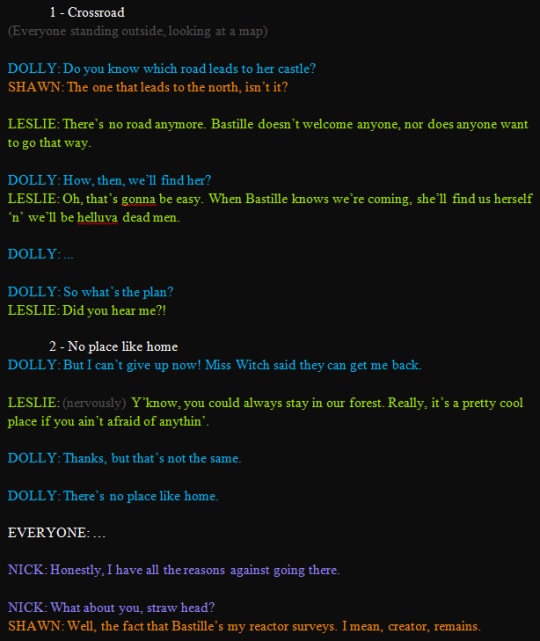
(notice that I approximately divided the pages & the text that’d go to each panel on a page)
6. Hard mode: make thumbnails for all the pages, if possible. At least whenever a new chapter starts.
7. If your story involves some convoluted chronology shenanigans, you’d better write down the events of your timeline in the chronological order.
8. Backgrounds. You can’t avoid them, bro. Like half of the comics are backgrounds, especially if your story involves a lot of adventuring and looking around. I know it hurts, but you’ll have to become friends with them. Read some tutorials, practice on photos, go out and sketch some streets, use 3d programs (like Google Sketch) to understand the perspective, use sites like houseplans to visualize your buildings better, I don’t know. Just be prepared for their imminent evil.
9. If you’re drawing digitally, pick a brush size for the lines and stick with it. You don’t want your lines and detail levels to look all wonky and inconsistent in different panels. And I don’t mean the cool stylistic varying lines, I mean this:
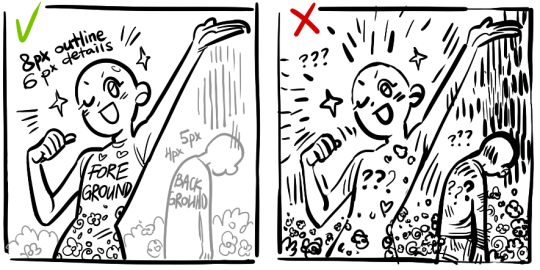
Also, things on the background should have thinner and/or lighter lines to avoid distraction. Usually less details too, unless you’re making a busy background with a simple foreground to help it pop out. Or wanna draw the attention to an object on the bg.

10. Readable fonts. Even if you chose to ignore people with poor sight or dyslexia, the majority of your readers aren’t gonna be excited about struggling to decypher this:

Also, as much as I love my black speech bubbles, colorful text on black still kinda hurts the eyes. I wouldn’t recommend doing that for all the characters. Black speech bubbles are usually used for creepy, inhuman voices. And yes, having a colorful outline in this case helps.
11. Probably newsflash, but did you know that panels have their place, order and functions? They do! My favourite thing ever is how I used panels when I was like 12:
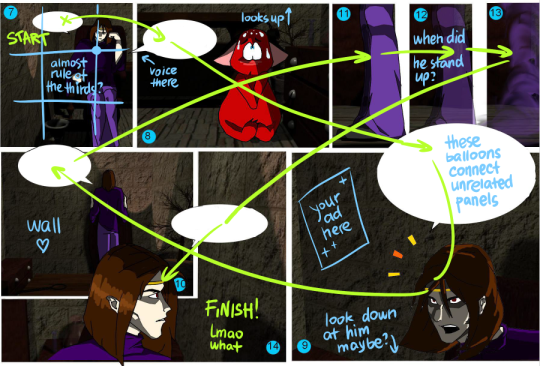
(comics ain’t rocket science, but this one is)
The composition of the panels and word balloons always serve for a better reading experience. They guide your eyes over the page, so that you never feel lost or confused. The images in the comic equal frames in a movie, so it’s pretty damn important in what order you look at things and how quickly you can understand what’s going on!

(Eric Shanower & Scottie Young’s Wizard of Oz)
12. One update a week is fine for testing waters. Don’t overestimate yourself, especially if you have a pretty busy life outside it. A stable comic that updates slowly, but regularly is better than an unpredictable erratic one. You can always pick up the pace later, if you feel confident enough.
13. Try to always have a buffer - a couple of pages in reserve. If you’re making the pages much faster than you’re updating, this shouldn’t be a problem. But if those paces are equally the same, it’s goddamn HARD. But on the other hand, if something happens and you skip an update, those come in handy.
If you’re looking at this list and thinking “wow that’s a LOT of work”, you’re totally right. And it’s okay to be intimidated at first! But that’s why it’s important to start with something small. Once you get the formula down, these things will be natural to you.
48K notes
·
View notes
Text
Porn being gone from Tumblr fucking sucks, but have you ever seen a post on Tumblr that you swear you’ve never seen before, and when you scroll down to like it, it’s already been liked?
136 notes
·
View notes
Photo

About a week ago I posted this.
I’ve been getting horrible messages like this in my ask for months, including:

and my personal favorite
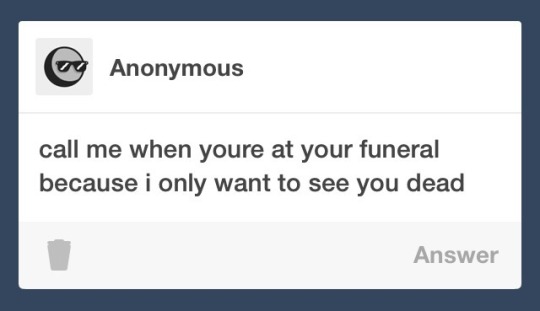
After getting the message saying “Just go kill yourself” I was completely done dealing with this person’s horrible messages and replied with just an “Okay.” and logged off tumblr.
About a week later I logged back on with 17 messages in my ask, most of them from the anon. I scrolled down and at first when I logged off, the anon messaged me things like
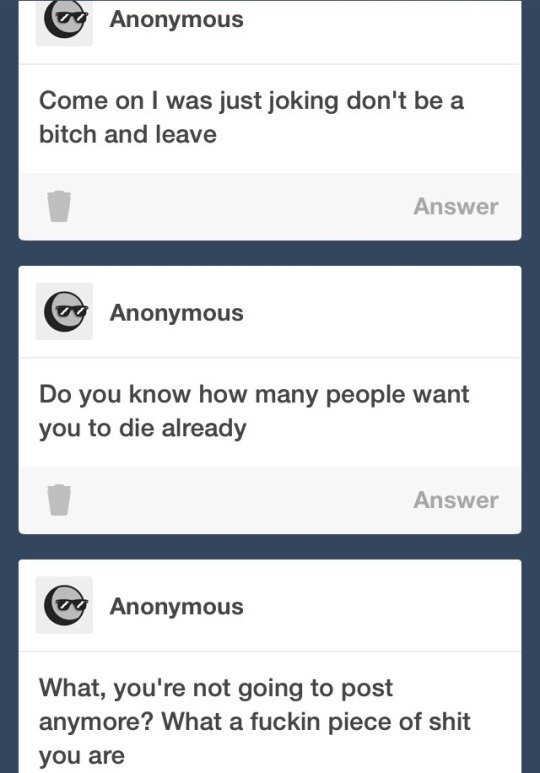
I scrolled up more and all of a sudden they started sending me more and more messages like
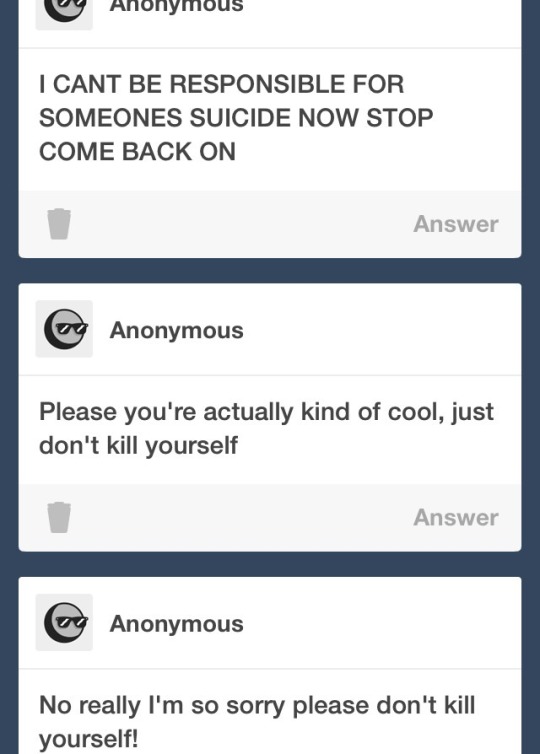
This was extremely surprising to me. I thought “After all those horrible messages you sent to me for MONTHS about hating me and wanting me dead, you say ‘sorry’ and that you ‘cant be responsible for someone’s suicide’?”
But I guess the lesson goes like this:
DONT TELL ANYONE TO KILL THEMSELVES UNLESS YOU ARE PREPARED FOR WHAT MIGHT ACTUALLY HAPPEN
639K notes
·
View notes
Text
Hey, so, I’m really struggling right now. I have -71$ in my bank account and have no money for food until I get paid over a week from now, or my bank account decides it wants to let me back into my savings.
If you’ve got any money to spare, I’m taking little chibi commissions like this :

For 10$ (sketch) or 15$ (colored).
OR if you’re feeling generous, my PayPal is [email protected] and my kofi can be found here
Thank you guys for your time 💙
202 notes
·
View notes
Photo





Commissions Open!
As you know I live in Venezuela and money is the first thing that always is scarce, so I must work constantly to be able to eat and keep expenses in my house, help is always good!
Payments via paypal, prices do not include paypal commission
Any questions or more information in Inbox or in my email [email protected]
Also do not forget to let us know if you want your drawing to be published or not
Explanation of special orders
Costume design / Character design: the work is about requesting a design without a specific description, if you want something more ambiguous you can only ask, for example, that it is a witch or a medieval character, its cost is due to the extra work of devising a design without much description
with the costumes goes the same, if you want to order a costume for a character
Character reference Sheet: the charge of 5 dollars is only only if you do not have references of your oc, if you want to build it from 0 and it gives me a detailed description of the character (hair and clothes photos and color reference can also be useful)
even if you want to make a sheet reference of your character and you already have drawings of it, you will not add the 5 dollars, there will only be extra charge if you ask for a separate outfit or expressions
here my Ko-fi
please reblog!!!
509 notes
·
View notes
Text
when you see a leaf on my hair
don’t remove leaf
leave it
don’t take it away
i don’t care if it’s huge
the leaf chose me
it’s my crown
it’s my leaf
we are one
87K notes
·
View notes
Text
It’s okay that you’re not who you thought you would be
555K notes
·
View notes
Photo

I hate to do this but I really need your help! After 4 days & 5 nights in complete darkness it’s time to get an electric generator but I don’t have the money for it, so I’m accepting donations if you want to help. I had commissions open as well as the pic says, but I already took too much on twitter ´v`Uu
You see, since march 7th, Venezuela has been under its worst problem ever: a massive power outage. It left the whole country without electricity and water for DAYS. If you don’t believe me, you can look at it in the news, it’s everywhere https://www.vox.com/world/2019/3/12/18261743/venezuela-blackout-power-guaido-maduro
Sadly, blackouts are a trigger for my anxiety, so I spent 4 days under constant anxiety, not eating for 2 days and without being able to sleep, which made a bit worse my delicate health condition. So, after that experience, my family and I decided to buy an electric generator bcus the electricity problem isn’t solved and we’re still prone to blackouts in the entire country.
But they’re waaaaaay to expensive for us and the $ we have are being used to buy non perishable food, candles and water, this is why I need your help, I don’t want to spend another five nights in darkness and not being able to sleep well due to my anxiety.
Thanks to the donations and commissions on twitter I’m closer to my goal, but it isn’t enough yet, so, if you can, please consider donate to my paypal link
http://www.paypal.me/cyborgvirus
even 1 usd helps a lot ;w;!! And if you can’t donate, then please reblog/spread this ; ; Thank you all!
656 notes
·
View notes
Photo
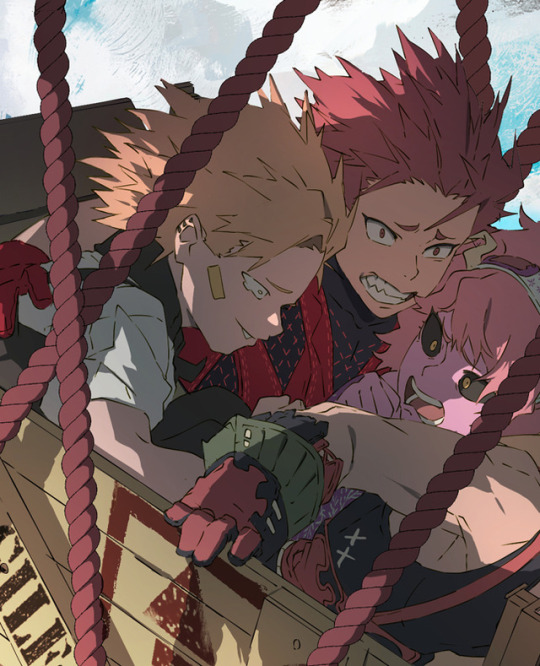
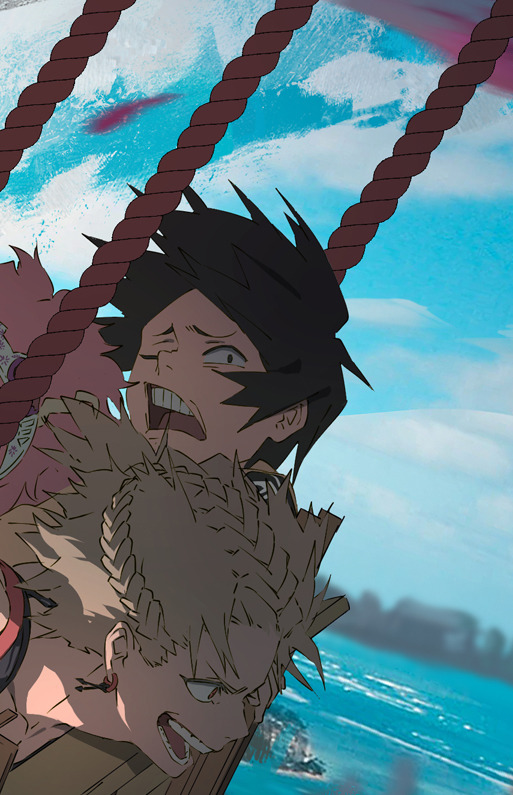
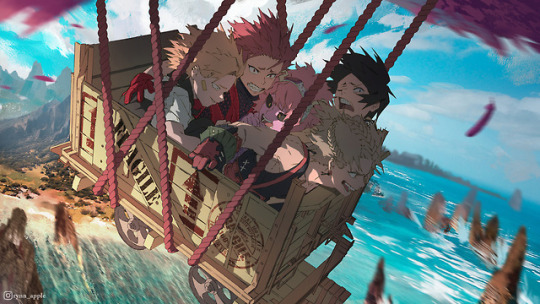
Baku-braids dragging his pals on his makeshift flying device. The purple wings is from a giant bird he killed earlier, I might draw that scene someday!
17K notes
·
View notes
Text
if u can pls consider donating to the victims/families of the ones affected by the terrorist attack!! you can donate here and here and if you live anywhere near christchurch pls donate blood!
4K notes
·
View notes
Text
@staff @support
kick nazis off the site. kick white supremacists off this site. kick true crime worshippers off this site. your site has been used not only to organize hate crimes and mass shootings but encourage them. people are already posting excerpts from the manifesto of a hate group that just destroyed dozens of lives and using your platform to promote it. when will enough be enough for you.
2K notes
·
View notes











